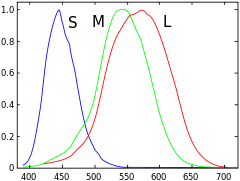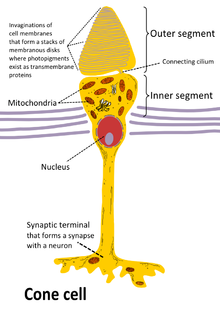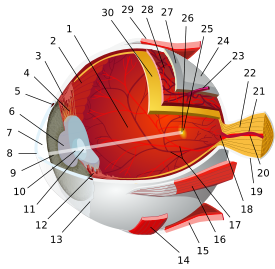- Cone cell
-
Neuron: Cone Cell 
Normalized responsivity spectra of human cone cells, S, M, and L typesNeuroLex ID sao1103104164 Code TH H3.11.08.3.01046 Cone cells, or cones, are photoreceptor cells in the retina of the eye that are responsible for color vision; they function best in relatively bright light, as opposed to rod cells that work better in dim light. Cone cells are densely packed in the fovea, but gradually become sparser towards the periphery of the retina.
A commonly cited figure of six million in the human eye was found by Osterberg in 1935.[1] Oyster's textbook (1999)[2] cites work by Curcio et al. (1990) indicating an average closer to 4.5 million cone cells and 90 million rod cells in the human retina.[3]
Cones are less sensitive to light than the rod cells in the retina (which support vision at low light levels), but allow the perception of colour. They are also able to perceive finer detail and more rapid changes in images, because their response times to stimuli are faster than those of rods.[4] Because humans usually have three kinds of cones with different photopsins, which have different response curves and thus respond to variation in colour in different ways, they have trichromatic vision. Being colour blind can change this, and there have been reports of people with four or more types of cones, giving them tetrachromatic vision.[5][6][7]
Contents
Types
Humans normally have three kinds of cones. The first responds most to light of long wavelengths, peaking at a yellowish colour; this type is sometimes designated L for long. The second type responds most to light of medium-wavelength, peaking at a green colour, and is abbreviated M for medium. The third type responds most to short-wavelength light, of a bluish colour, and is designated S for short. The three types have peak wavelengths near 564–580 nm, 534–545 nm, and 420–440 nm, respectively.[8][9] The difference in the signals received from the three cone types allows the brain to perceive all possible colours, through the opponent process of colour vision. (Rod cells have a peak sensitivity at 498 nm, roughly halfway between the peak sensitivities of the S and M cones.)
The colour yellow, for example, is perceived when the L cones are stimulated slightly more than the M cones, and the colour red is perceived when the L cones are stimulated significantly more than the M cones. Similarly, blue and violet hues are perceived when the S receptor is stimulated more than the other two.
The S cones are most sensitive to light at wavelengths around 420 nm. However, the lens and cornea of the human eye are increasingly absorptive to smaller wavelengths, and this sets the lower wavelength limit of human-visible light to approximately 380 nm, which is therefore called 'ultraviolet' light. People with aphakia, a condition where the eye lacks a lens, sometimes report the ability to see into the ultraviolet range.[10] At moderate to bright light levels where the cones function, the eye is more sensitive to yellowish-green light than other colors because this stimulates the two most common (M and L) of the three kinds of cones almost equally. At lower light levels, where only the rod cells function, the sensitivity is greatest at a blueish-green wavelength.
Cones also tend to posses a significantly elevated visual acuity because each cone cell has a lone connection to the optic nerve, therefore, the cones have an easier time to tell that two stimuli are isolated.[11]
Structure
Cone cells are somewhat shorter than rods, but wider and tapered, and are much less numerous than rods in most parts of the retina, but greatly outnumber rods in the fovea. Structurally, cone cells have a cone-like shape at one end where a pigment filters incoming light, giving them their different response curves. They are typically 40-50 µm long, and their diameter varies from 0.5 to 4.0 µm, being smallest and most tightly packed at the center of the eye at the fovea. The S cones are a little larger than the others.[citation needed]
Photobleaching can be used to determine cone arrangement. This is done by exposing dark-adapted retina to a certain wavelength of light that paralyzes the particular type of cone sensitive to that wavelength for up to thirty minutes from being able to dark-adapt making it appear white in contrast to the grey dark-adapted cones when a picture of the retina is taken. The results illustrate that S cones are randomly placed and appear much less frequently than the M and L cones. The ratio of M and L cones varies greatly among different people with regular vision (e.g. values of 75.8% L with 20.0% M versus 50.6% L with 44.2% M in two male subjects).[12]
Like rods, each cone cell has a synaptic terminal, an inner segment, and an outer segment as well as an interior nucleus and various mitochondria. The synaptic terminal forms a synapse with a neuron such as a bipolar cell. The inner and outer segments are connected by a cilium.[4] The inner segment contains organelles and the cell's nucleus, while the outer segment, which is pointed toward the back of the eye, contains the light-absorbing materials.[4]
Like rods, the outer segments of cones have invaginations of their cell membranes that create stacks of membranous disks. Photopigments exist as transmembrane proteins within these disks, which provide more surface area for light to affect the pigments. In cones, these disks are attached to the outer membrane, whereas they are pinched off and exist separately in rods. Neither rods nor cones divide, but their membranous disks wear out and are worn off at the end of the outer segment, to be consumed and recycled by phagocytic cells.
The response of cone cells to light is also directionally nonuniform, peaking at a direction that receives light from the center of the pupil; this effect is known as the Stiles–Crawford effect.
See also
- Colour blindness
- Colour vision
- Cone dystrophy
- Double cones
- Tetrachromacy
- Rod cell
- Disc shedding
References
- ^ G. Osterberg (1935). “Topography of the layer of rods and cones in the human retina,” Acta Ophthalmol., Suppl. 13:6, pp. 1–102.
- ^ Oyster, C. W. (1999). The human eye: structure and function. Sinauer Associates.
- ^ Curcio, CA.; Sloan, KR.; Kalina, RE.; Hendrickson, AE. (Feb 1990). "Human photoreceptor topography.". J Comp Neurol 292 (4): 497–523. doi:10.1002/cne.902920402. PMID 2324310.
- ^ a b c Kandel, E.R.; Schwartz, J.H, and Jessell, T. M. (2000). Principles of Neural Science (4th ed.). New York: McGraw-Hill. pp. 507–513.
- ^ Jameson, K. A., Highnote, S. M., & Wasserman, L. M. (2001). "Richer colour experience in observers with multiple photopigment opsin genes" (PDF). Psychonomic Bulletin and Review 8 (2): 244–261. doi:10.3758/BF03196159. PMID 11495112. http://www.klab.caltech.edu/cns186/papers/Jameson01.pdf.
- ^ "You won't believe your eyes: The mysteries of sight revealed". The Independent. 7 March 2007. http://news.independent.co.uk/world/science_technology/article2336163.ece.
- ^ Mark Roth (September 13, 2006]). "Some women may see 100,000,000 colours, thanks to their genes". Pittsburgh Post-Gazette. http://www.post-gazette.com/pg/06256/721190-114.stm.
- ^ Wyszecki, Günther; Stiles, W.S. (1982). Colour Science: Concepts and Methods, Quantitative Data and Formulae (2nd ed.). New York: Wiley Series in Pure and Applied Optics. ISBN 0-471-02106-7.
- ^ R. W. G. Hunt (2004). The Reproduction of Colour (6th ed.). Chichester UK: Wiley–IS&T Series in Imaging Science and Technology. pp. 11–12. ISBN 0-470-02425-9.
- ^ Let the light shine in: You don't have to come from another planet to see ultraviolet light EducationGuardian.co.uk, David Hambling (May 30, 2002)
- ^ S.J. Ethan (2009) Pentachromacy VolvPress. pp. 20-46
- ^ Roorda A., Williams D.R. (1999). "The arrangement of the three cone classes in the living human eye". Nature 397 (6719): 520–522. doi:10.1038/17383. PMID 10028967.
External links
- Cell Centered Database - Cone cell
- Webvision's Photoreceptors
- NIF Search - Cone Cell via the Neuroscience Information Framework
- Model and image of cone cell
Sensory system – visual system – globe of eye (TA A15.2.1–6, TH 3.11.08.0-5, GA 10.1005) Fibrous tunic (outer) Uvea/vascular tunic (middle) Retina (inner) LayersCellsPhotoreceptor cells (Cone cell, Rod cell) → (Horizontal cell) → Bipolar cell → (Amacrine cell) → Retina ganglion cell (Midget cell, Parasol cell, Bistratified cell, Giant retina ganglion cells, Photosensitive ganglion cell) → Diencephalon: P cell, M cell, K cell
Muller gliaOtherAnterior segment Posterior segment Other M: EYE
anat(g/a/p)/phys/devp/prot
noco/cong/tumr, epon
proc, drug(S1A/1E/1F/1L)
Categories:- Photoreceptor cells
- Eye anatomy
- Human cells
- Neurons
Wikimedia Foundation. 2010.




